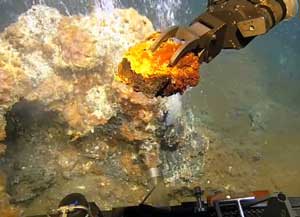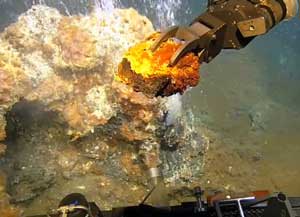 NARRAGANSETT, R.I. – September 15, 2011 — University of Rhode Island volcanologist Steven Carey is participating in a scientific investigation of hydrothermal vents in the crater of an ancient underwater volcano off the coast of Greece. He is helping to direct remotely operated vehicles deployed from the exploration ship Nautilus to collect water and sediment samples, and he is discussing the findings with shipboard scientists.
NARRAGANSETT, R.I. – September 15, 2011 — University of Rhode Island volcanologist Steven Carey is participating in a scientific investigation of hydrothermal vents in the crater of an ancient underwater volcano off the coast of Greece. He is helping to direct remotely operated vehicles deployed from the exploration ship Nautilus to collect water and sediment samples, and he is discussing the findings with shipboard scientists.
But Carey isn’t aboard the Nautilus. He’s not even in Greece or elsewhere in Europe. He is sitting in the Inner Space Center at URI, where he can participate in the research expedition from thousands of miles away without having to spend weeks at sea.
“I can direct things as easily from here as I could if I were on the ship,” said Carey, a professor at URI’s Graduate School of Oceanography. “I can see the same video as they see, and when I’m talking on the intercom, I’m having a similar experience as if I were there.”
The Inner Space Center is the brainchild of marine explorer and URI Professor Robert Ballard, who envisioned just such a facility 30 years ago and who worked throughout his career to make it a reality. Modeled after Mission Control at the Johnson Space Center in Houston, the facility, which opened in 2010, connects scientists aboard oceanographic research ships with scientists ashore in real-time via satellite “telepresence” technologies.
According to Dwight Coleman, director of the Center, it is the only facility of its kind in the world, and it is helping to make URI the hub of oceanographic research and exploration. Live video from the Nautilus is being broadcast to the Inner Space Center through mid-November this year, and the Center has also been receiving video from the Okeanos Explorer, a ship operated by the National Oceanic and Atmospheric Administration, including its studies near the Galapagos Islands and in the Caribbean. Other research ships could also be connected to the facility in real-time.
The Inner Space Center enables URI students to participate remotely on oceanographic expeditions, as well, even when there isn’t space aboard ship. And scientists at several partner institutions have compatible technology to communicate with the Inner Space Center in their offices or labs.
In addition, the facility includes a television production room where live and prerecorded educational videos can be produced for use on the Internet and other digital media outlets.
Steven Carey’s studies in the crater of the Kolumbo underwater volcano are designed to discover whether the carbon dioxide bubbling out of the hydrothermal vents in the crater is making the water more acidic and affecting marine life in the area.
“It’s great that I can sit here and direct the research operations from halfway around the world, with no chance of getting seasick,” he said.

